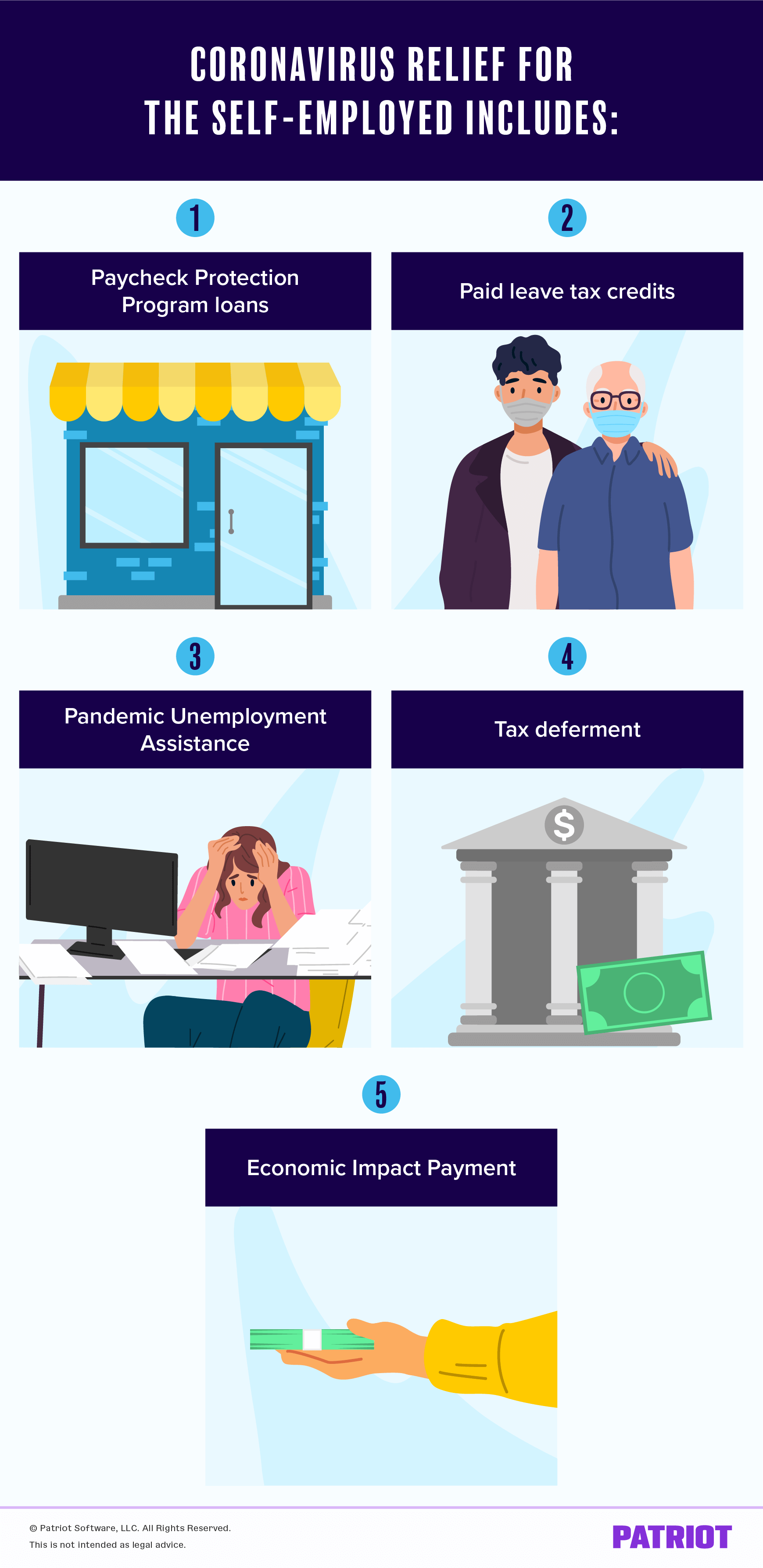The Families First Coronavirus Response Act (FFCRA) and Coronavirus Aid, Relief, and Economic Security Act (CARES Act) provide relief options for businesses and workers. A number of these measures provide help for self-employed individuals without employees, too.
Learn what kind of COVID-19 help you may be eligible to receive if you’re self-employed.
Coronavirus help for self-employed
The two emergency bills passed in response to the coronavirus, the FFCRA and CARES Act, extend a number of relief options to self-employed individuals.
Coronavirus relief for the self-employed include:
- Paycheck Protection Program loans
- Paid leave tax credits
- Pandemic Unemployment Assistance
- Tax deferment
- Economic Impact Payment

1. Paycheck Protection Program loan for self-employed
The Paycheck Protection Program (PPP) is undoubtedly the most talked-about COVID-19 relief measure for small businesses. And thankfully, self-employed individuals are also eligible to take out a forgivable loan.
Between April 10, 2020 – June 30, 2020, self-employed individuals can apply for a loan to cover eight weeks of their payroll, mortgage interest, rent, and utility expenses. Wages, commissions, income, or net earnings from self-employment must be capped at $100,000 annually.
Keep in mind that the PPP loan forgiveness cap for self-employed individuals is the lesser of:
- 8/52 of 2019 compensation (i.e., 15.38% of your 2019 compensation)
- $15,385
Self-employed individuals can fill out an application form and apply through an approved lender. The form asks for your average payroll costs over an eight-week period, plus 25%, to determine your loan amount.
If you use 75% of your loan to cover payroll costs and 25% to cover mortgage interest, rent, and utility payments, you may be eligible for loan forgiveness on the principal amount. Otherwise, you have two years to pay the loan off, and it accrues interest at a fixed rate of 1%.
Keep detailed records showing what you used the loan funds for and submit them to your lender when asking for forgiveness. If your loan is forgiven, you can no longer defer the employer portion of Social Security tax (explained later).
2. Paid leave tax credits
Employers with fewer than 500 employees are responsible for providing coronavirus paid sick leave and paid family leave to eligible employees. To help offset these costs, the employers qualify to receive a paid sick or paid family leave tax credit, also called FFCRA payroll tax credits.
The IRS says that certain self-employed individuals can take advantage of these credits, too. If you are self-employed and eligible for paid leave wages under the FFCRA, you can fund the wages with part of your estimated income taxes.
You qualify for paid sick leave equal to the number of days you can’t work (10 days max), multiplied by the lesser of $511 or 100% of your average daily self-employment income, if:
- You are subject to a COVID-19 quarantine or isolation order from the government,
- Were advised by a healthcare provider to self-quarantine, OR
- Have COVID-19 symptoms and are seeking a medical diagnosis
You qualify for paid sick or family leave equal to the number of days you can’t work, multiplied by the lesser of $200 or 67% of your average daily self-employment income, if:
- You are caring for someone who meets the above three criteria (paid sick leave)
- Your child’s school or place of care closed due to COVID-19 (paid family leave, 50 days max)
- You’re experiencing a similar condition specified by the Secretary of Health and Human Services in consultation with the Secretary of the Treasury and Secretary of Labor (paid sick leave)
To find your average daily self-employment income, divide your net earnings from self-employment for the taxable year and divide by 260.
Claim the credit on your 2020 Form 1040, U.S. Individual Income Tax Return, for credits you take in 2020. Claim the credit on your 2021 Form 1040 for credits you take in 2021. You can determine your FFCRA tax credits with the IRS’s Form 7202, Credits for Sick Leave and Family Leave for Certain Self-Employed Individuals.”
3. Pandemic Unemployment Assistance
Another coronavirus measure providing help for self-employed individuals is the Pandemic Unemployment Assistance (PUA). Typically, self-employed individuals are not eligible for unemployment benefits because they do not pay into the program. But, PUA gives states the option to extend benefits to self-employed individuals through additional funding.
Check with your state to determine if you can receive extended unemployment benefits. You must be unable to work because of the coronavirus to qualify, too.
The PUA provides up to 39 weeks of unemployment benefits between January 27, 2020 – December 31, 2020. You can receive benefits retroactively.
4. Tax deferment
To help businesses and individuals alike, the government extended the deadline for the following types of taxes:
- Federal income tax
- Estimated tax payments
- Employer portion of Social Security tax
Federal income tax filing and payments now have a deadline of July 15, 2020 rather than April 15, 2020, without penalties or interest.
Estimated tax payments also have a tax payment extension. If you are self-employed and make estimated tax payments, your first and second quarter deadlines are July 15, 2020. Originally, first quarter payments were due April 15, 2020 and second quarter payments were due June 15, 2020.
The employer portion of Social Security tax deferment under the CARES Act also applies to self-employed individuals. According to the IRS, you can defer paying 50% of your Social Security tax on net earnings from self-employment income (aka, the “employer” portion of the tax) between March 27, 2020 – December 31, 2020. You have until December 31, 2021 to deposit 50% of the deferred amount and until December 31, 2022 to deposit the remainder.
Again, if you applied for a PPP loan, you must stop deferring Social Security tax payments when your lender tells you your loan is forgiven.
5. Economic Impact Payment
Economic Impact Payments are government-issued stimulus checks to help individuals during the pandemic. Both non-filers and filers may be eligible for the payment—including the self-employed.
The stimulus check is worth $1,200 per U.S. adult. You are eligible for the full $1,200 stimulus check if your adjusted gross income is less than:
- $75,000 (individuals)
- $112,500 (head of household)
- $150,000 (married filing jointly)
You are eligible for a reduced stimulus check if your adjusted gross income is between:
- $75,000 – $99,000 (individuals)
- $112,500 – $136,500 (head of household)
- $150,000 – $198,000 (married filing jointly)
If your adjusted gross income is more than $99,000 (individuals), $136,500 (head of household), or $198,000 (married filing jointly), you likely will not qualify.



